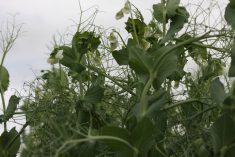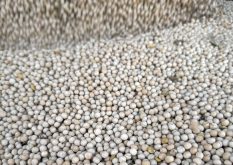Pea breeders are heading back to U.S. and French roots in search of genes for durable resistance against aphanomyces
Commercial pea varieties in Western Canada have some resistance to aphanomyces, a stubborn soil pathogen that causes root rot.
Greenhouse testing at the University of Saskatchewan has shown that several varieties have partial resistance. But those results come with a large asterisk: indoor conditions are very different from field conditions.
“Among the group with better resistance in the indoor testing are AAC Ardill, AAC Aberdeen, CDC Amarillo, CDC Lewochko and AAC Profit… yellow pea varieties that are being grown on a relatively large scale in Western Canada,” said Tom Warkentin, a field pea and soybean breeder at the U of S.
Read Also

Fertilizer method’s link to emissions studied
A researcher says others studying greenhouse gas emissions aren’t considering how the loss of nitrogen into the atmosphere correlates with fertilizer application or if there is an impact to yield.
“I don’t want to make strong recommendations to growers based on these data alone, but (this) encourages us to explore these apparent differences further.”
Warkentin said that in greenhouse tests, the pea plants were “challenged” by only one type of aphanomyces. In the field, plants would likely be exposed to multiple strains, as well as other root rot pathogens.
“It’s a more complex environment.”
Still, the indoor results are interesting and Warkentin can use the data for future research.
“We plan to explore these varieties at the DNA marker level, to try to determine whether or not they carry any of the known QTLs… associated with aphanomyces resistance,” he said.
A QTL is a Quantitative Trait Loci, a region of the genome associated with a trait in a plant.
In this case, the trait is resistance to aphanomyces.
Western Canadian growers need varieties with some resistance to root rot, because aphanomyces has become a massive challenge for pea and lentil growers. Spores from the disease have infected hundreds or thousands of fields in Western Canada.
“Aphanomyces root rot causes severe damage to the roots, causing infected plants to wilt and die prematurely. In wet years, high yield loss in peas has been observed under … high infections,” says SaskPulse’s website.
Unfortunately, the crop protection industry and researchers haven’t discovered fungicides or genetic resistance to the disease. The main option is waiting six to eight years for spore counts to drop before growing peas or lentils again.
There might be partial genetic resistance in a variety like AAC Ardill, but Warkentin urged caution. There’s no guarantee it will perform in a field with billions of aphanomyces spores in the soil.
The more positive news?
There are new varieties of peas in the development pipeline, bred with partial resistance to root rots.
Warkentin and his colleagues looked into the past to solve today’s problem.
“We have basically gone back to the original sources of partial resistance. Those were described 20-30 years ago, mainly by John Kraft, a colleague who worked for the USDA in Washington State.”
Warkentin also relied on partnerships with scientists in Minnesota and France to find genetic resistance in older pea varieties.
But again, it’s not one or two genes in those varieties. It’s a sizable group of genes in the pea’s DNA.
“We’re trying to bring in those specific (genomic) regions … into varieties that are performers in Western Canada,” Warkentin said. “Some promising lines are now in registration trials…. I think it is better to wait for these to reach the market, along with clear recommendations on how they should be deployed, in terms of rotations, to protect these resistances from breaking down.”
Farmers cannot rely on partial resistance to aphanomyces. They will need biological products for root rot and crop sequences that keep soil pathogens in check.
If partial resistance and integrated pest management are effective, producers could plant peas more often on the same field.
“We used to talk about pea or lentils, one in four (years),” Warkentin said. “I would hope we could go back to that type of rotation without too much risk.”
















